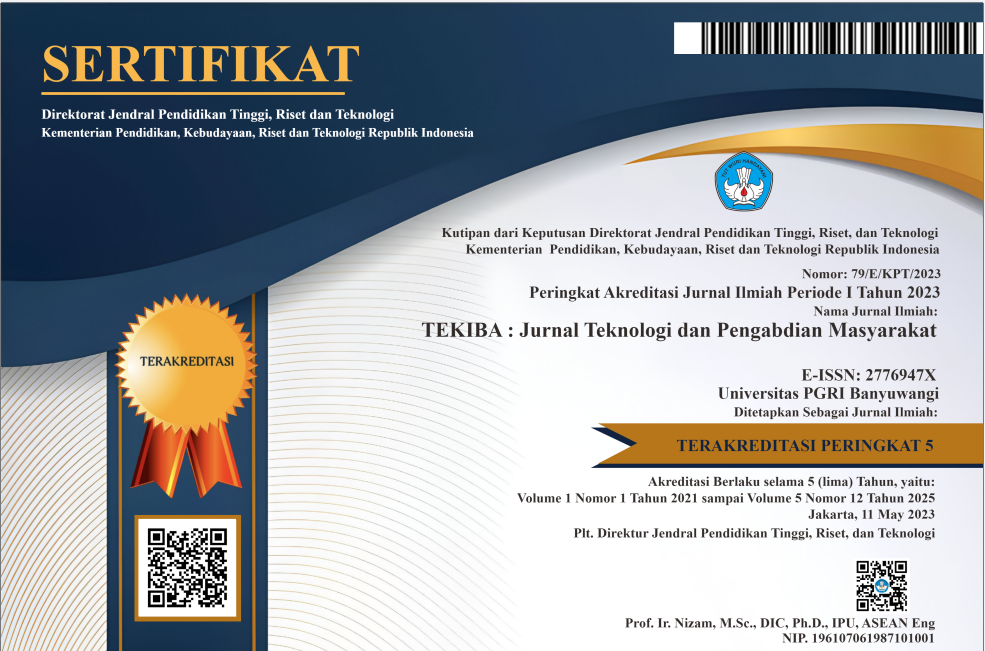Aplikasi Teknologi QR Code Pada Identifikasi Tumbuhan Di Wisata De-Djawatan
DOI:
https://doi.org/10.36526/tekiba.v2i1.1583Keywords:
QR Code, De-Djawatan, PlantsAbstract
De-Djawatan Tourism Destinations are known by various tourists both local and non-local with their natural beauty in the form of large and lush trees that are still beautiful or natural. De-Djawatan tourism does not yet have detailed information either manually or digitally related to the biological and general classification of plants in that location. As smartphone technology develops, the information needed to be very easy to obtain. QR Code is one method to obtain complete information. QR Code is a type of two-dimensional image that displays data in the form of text. This community partnership program aims to provide appropriate technology in the form of the QR code method in determining the identification of plants found in De-Djawatan tourist destinations. This aims to make it easier for tourists to find information on various plants both biologically and in general.
The stages of program implementation start from the observation stage, media creation, and implementation. The results of this program using the QR Code can include the identity of the identification results of plants, such as division, order, family, genus and species of plants in the De-Djawatan location. In this QR Code method there are features such as Home, Collection, and Admin. Before the QR Code is created, the document data is encrypted and then used as a QR Code. The result of scanning the QR Code is in the form of a Uniform Resource Locator (URL) that points to the document data. When the URL is executed on the web browser, the system performs a description of the URL, then it is matched with the database, and then displayed to the web browser. The final result is a Document Validation application in the form of a QR Code which is used to convey plant identification information, such as division, order, family, genus and species of plants.
References
Khadijah, U, L, S., Novianti, E.,. 2019.Potensi Pariwisata Jawa Barat. Unpad Press.
Wave, D. (2018), “QR Code development story” https://www.denso-wave.com/en/technology/vol1.html, diakses 28
November 2021.
Putra, Y,T,A., Bisenna. I, K,., Kartini, K.S., 2018. Pengembangan Sistem Inventaris Berbasis Qr Code Menggunakan Web Service Pada Bidang Sarana Dan Prasarana Stmik Stikom Indonesia. Jurnal Nasional Pendidikan Teknik Informatika, Volume 7(3), pp.315-323.
I. G. B. Jawi,. 2017. Pemindaian QR Code Untuk Aplikasi Penampil Informasi Data Koleksi Di Museum Sangiran Sragen Berbasis Android,” Volume 17(1) pp. 6–8,
Sugiantoro, B. & Hasan, F. 2015. Pengembangan QR Code Scanner Berbasis Android Untuk Sistem Informasi Museum Sonobudoyo Yogyakarta. Telematika, Volume 12(02), pp.69-72
Dagan, I. Binyamin, G. & Eilam, A.. 2016. Delivery of QR Codes to Cellurar Phones throught Data Embedding in Audio, International Conference on the Science of Electrical Engineering, DOI:
1109/ICSEE.2016.7806076.
Bajpai, M.K. .2015. Researching throught QR Codes in Libraries, International Symponisum on Energing and Technologies in Libraries and
Information Services, 291-294, DOI: 10.1109/ETTLIS.2015.7048214
Jawi, I, G, B., Supriyono, H., 2017. Pemindaian QR Code Untuk Aplikasi Penampil Informasi Data Koleksi Di Museum Sangiran Sragen Berbasis Android. Emitor: Jurnal Teknik Elektro.Volume 17 (1). pp. 6-8.
Prathivi, R.2018. Analisa Sistem Qr Code Untuk Identifikasi Buku Perpustakaan. Jurnal Pengembangan Rekayasa dan Teknologi. Volume 14(2). pp. 37-40
. Novan Adi Musthofa, N, A.., Mutrofin, S., Murtadho, M,A., 2016. Implementasi Quick Response (Qr) Code Pada Aplikasi Validasi Dokumen Menggunakan Perancangan Unified Modelling Language (UML). Jurnal Antivirus. Volume 10(1). pp. 42-50.
Susanti, E., Iswahyudi, C., Romadhani, T, Wahyuningsih, S., Putra, F,T., 2018.
Pemanfaatan Teknologi Quick Response (Qr) Code Pada
Sistem Manajemen Studi Ekskursi. Simposium Nasional RAPI XVII-FT UMS. pp.110-118.
Downloads
Published
Issue
Section
License
Copyright (c) 2022 Charis Fathul Hadi, Ratna Mustika Yasi, Cici Agustin

This work is licensed under a Creative Commons Attribution-ShareAlike 4.0 International License.









